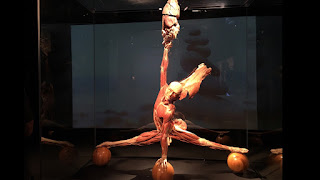Week 8: Nanotechnology and Art
Blog #8: Nanotechnology and Art
 |
| Drexler's assembly line |
This week’s topic was Nanotechnology and Art, taught by guest lecturer Dr. Gimzewski. One of the things that caught my attention was Drexler’s theoretical “nano assembly line.” His idea was that nanotech mechanical arms could be arranged in an assembly line to move atoms around one by one. In this way, dirt could be input and the arms could rearrange the atoms to create a burger for example. Dr. Gimzewski compared this to what a cow does; eating grass and dirt and growing meat on their bones to be turned into a burger. The thought that this is possible was mind-blowing to me, until Skalley sort of disproved its likelihood.
 |
| Geodesic dome by Buckminster Fuller |
Skalley struck me as important in another way, though. His discovery of the “Buckyball” carbon structure likely wouldn't have taken place if he hadn’t taken interest in architecture. Through spectroscopy he knew that an atomic structure composed of 60 carbons existed, but not how they were arranged. This puzzle baffled him until he thought of the architect Buckminster Fuller, who had been creating pentagonally-isolated domes for homes in California. This is a wonderful example of why I believe learning should be multi-dimensional and not so specialized in one area. Nowadays, the education system and employers seem to ardently believe that their employees should be experts in a minute, singular field and thats it — but this phenomenon can actually be an inhibitor to progress.
 |
| Nanotech food |
The last thing that really stuck out to me from this weeks material was that there are already thousands of nanotech products on the market that we have no idea we are consuming. It seems foolish at best and immoral at worst that companies are putting nanotech foods and skin products on the market without warning their customers. The long-term effects of such products are unknown and this is actually very scary. Testing nanotechnology first in things that we put in our bodies does not seem like the safest path to progress in this field. As Dr. Gimzewski said, “I do not recommend that you try it, and early studies suggest the need for caution.”
Works Cited
“Art in the Age of Nanotechnology.” Artabase. N.p., n.d. Web. 23 Nov. 2012. <http://www.artabase.net/exhibition/2104-art-in-the-age-of-nanotechnology>.
“Bucky's Biggest Geodesic Dome to Be Restored | Design | Agenda.” Phaidon, www.phaidon.com/agenda/design/articles/2013/march/13/buckys-biggest-geodesic-dome-to-be-restored/.
Gimzewski, Jim, and Victoria Vesna. “Nanotechnology and Art, Part 1-6;” YouTube, www.youtube.com/watch?time_continue=536.
Gimzewski, Jim, and Victoria Vesna. The Nanomeme Syndrome: Blurring of Fact & Fiction in the Construction of a New Science. N.p., n.d. Web. 23 Nov. 2012. <http://vv.arts.ucla.edu/publications/publications/02-03/JV_nano/JV_nano_artF5VG.htm>.
Hayes, Wallace, and Saura Sahu. “Nanotechnology in the Food Industry: A Short Review.” Food Safety Magazine, Mar. 2017, www.foodsafetymagazine.com/magazine-archive1/februarymarch-2017/nanotechnology-in-the-food-industry-a-short-review/.
“History of the Nanofactory.” Responsible Nanotechnology, crnano.typepad.com/crnblog/2006/08/history_of_the_.html.
“Nanotechnology - Nano Foods - Lab Created Foods We Buy.” YouTube, YouTube, 9 July 2017, www.youtube.com/watch?v=8P095qz4e0M.


I really enjoyed your blog this week. It is crazy to think that some companies are using nanotechnology in food and other such products. Like in your third picture, it is possible that we may be eating pills that contain the nutrients of full meals that we eat present day. Even though there are less practical uses like this one, their are also some amazing things that can be done with nanotech. Just imagine some of the advancements in medicine that could occur. Pill could have nanotech that attack certain diseases or Cancers. The possibilities are endless.
ReplyDeleteI enjoyed your perspective on a multi-disciplinary education process. I agree that an understanding and enjoyment of more than one discipline is important to make an individual a more valuable contributor to society. However, I also believe that taking an interest in many disciplines also allows one to enjoy the world more completely as well. In addition, I agree with your concerns about nanoparticles and companies warning their consumers. However, the lectures we watch for class are from 2012 and many of those safety concerns have been well researched and disproven. For example, in class a few weeks ago I learned that nanoparticles are actually very easily purged from the body because they are all usually developed to be the exact size (50-150 nm) necessary for endocytosis by macrophages (one of the cells responsible for eliminating foreign objects and toxins from our body). In addition, most nanoparticles used in the food industry today are used in food encapsulation and packaging. In general, nanoparticles at appropriate dosages are manageable by our body, so I wouldn't worry about nanoparticles in consumer products harming you.
ReplyDeleteI definitely agree with your take on nanotechnology in consumer products! It is scary to think that things we regularly consume could have harmful chemicals and particles in them, unbeknownst to us. The above comment notes that most concerns have been disproven, which is good to know. However, I was talking with my roommate this morning about GMOs, which similarly lack labeling and are in things we consume every day. Unfortunately, GMOs have been proven to be harmful, and are still not labeled on our packaging. This leads me to wonder if, had nanoparticles been proven dangerous, they would have been labeled differently, or would we be facing the same situation as we currently are with GMOs?
ReplyDelete